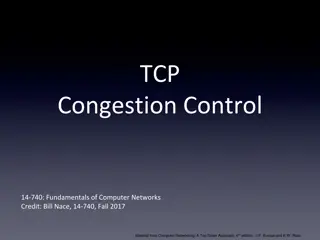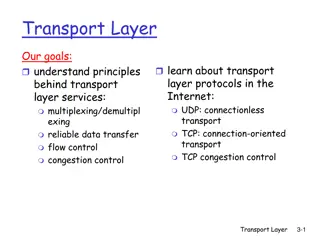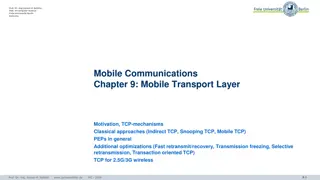Experiments with Data Center Congestion Control Research
This presentation shares insights from research on data center congestion control, covering various protocols and projects from 2009 to 2015. It delves into the PIAS project's mechanisms and implementation efforts, emphasizing the importance of Flow Completion Time (FCT) in optimizing data center applications for low latency and efficient performance. The PIAS key idea revolves around Multi-Level Feedback Queue (MLFQ) to prioritize flows effectively, particularly beneficial for heavy-tailed DCN traffic.
Download Presentation

Please find below an Image/Link to download the presentation.
The content on the website is provided AS IS for your information and personal use only. It may not be sold, licensed, or shared on other websites without obtaining consent from the author.If you encounter any issues during the download, it is possible that the publisher has removed the file from their server.
You are allowed to download the files provided on this website for personal or commercial use, subject to the condition that they are used lawfully. All files are the property of their respective owners.
The content on the website is provided AS IS for your information and personal use only. It may not be sold, licensed, or shared on other websites without obtaining consent from the author.
E N D
Presentation Transcript
Experiments with Data Center Congestion Control Research Wei Bai APNet 2017, Hong Kong 1
The opinions of this talk do not represent the official policy of HKUST and Microsoft 2
Data Center Congestion Control Research 2009: TCP retransmissions 2010: DCTCP, ICTCP 2011: D3, MPTCP 2012: PDQ, D2TCP, ECN 2013: pFabric 2014: PASE, Fastpass, CP 2015: DCQCN, TIMELY, PIAS . 3
This talk is about our experience on PIAS project. Joint work with Li Chen, Kai Chen, Dongsu Han, Chen Tian, Hao Wang HotNets 2014, NSDI 2015 and ToN 2017 4
Outline PIAS mechanisms Implementation efforts for NSDI submission Efforts after NSDI Takeaway from PIAS experience 5
Outline PIAS mechanisms Implementation efforts for NSDI submission Efforts after NSDI Takeaway from PIAS experience 6
Flow Completion Time (FCT) is Key Data center applications Desire low latency for short messages App performance & user experience Goal of DCN transport: minimize FCT 7
PIAS Key Idea PIAS performs Multi-Level Feedback Queue (MLFQ) to emulate Shortest Job First (SJF) Priority 1 High Priority 2 Low Priority K 8
PIAS Key Idea PIAS performs Multi-Level Feedback Queue (MLFQ) to emulate Shortest Job First (SJF) Priority 1 Priority 2 Priority K 9
PIAS Key Idea PIAS performs Multi-Level Feedback Queue (MLFQ) to emulate Shortest Job First (SJF) In general, PIAS short flows finish in higher priority queues while large ones in lower priority queues, emulating SJF, effective for heavy tailed DCN traffic. 10
How to implement MLFQ? Implementing MLFQ at switch directly not scalable Requires switch to keep per-flow state Priority 1 Priority 2 Priority K 11
How to implement MLFQ? Decoupling MLFQ Stateless Priority Queueing at the switch (a built-in function) Stateful Packet Tagging at the end host Priority 1 - K priorities: Pi 1 i K K 1 thresholds: j1 j K 1 - Threshold from Pj 1to Pjis: j 1 Priority 2 K priorities: Pi 1 i K K 1 thresholds: j 1 j K 1 Threshold from Pj 1to Pjis: j 1 Priority K K priorities: Pi 1 i K K 1 thresholds: j 1 j K 1 Threshold from Pj 1to Pjis: j 1 12
How to implement MLFQ? Decoupling MLFQ Stateless Priority Queueing at the switch (a built-in function) Stateful Packet Tagging at the end host i Priority 1 - K priorities: Pi 1 i K K 1 thresholds: j1 j K 1 - Threshold from Pj 1to Pjis: j 1 Priority 2 K priorities: Pi 1 i K K 1 thresholds: j 1 j K 1 Threshold from Pj 1to Pjis: j 1 Priority K K priorities: Pi 1 i K K 1 thresholds: j 1 j K 1 Threshold from Pj 1to Pjis: j 1 13
Threshold vs Traffic Mismatch DCN traffic is highly dynamic Threshold fails to catch traffic variation mismatch 10MB Ideal, threshold = 20KB 10MB High Low Too small, 10KB ECN 20KB 14 Too big, 1MB
PIAS in 1 Slide PIAS packet tagging Maintain flow states and mark packets with priority PIAS switch Enable strict priority queueing and ECN PIAS rate control Employ Data Center TCP to react to ECN 15
Outline Key idea of PIAS Implementation efforts for NSDI submission Efforts after NSDI Takeaway from PIAS experience 16
Implementation Stages ECN-based transport DCTCP at the end host ECN marking at the switch MLFQ scheduling Packet tagging module at the end host Priority queueing at the switch Evaluation Measure FCT using realistic traffic 17
Integrate DCTCP into Linux Kernel DCTCP was not integrated into Linux in 2014 Linux patch provided by the authors 18
Integrate DCTCP into Linux Kernel DCTCP was not integrated in Linux in 2014 Linux patch provided by the authors PASS 19
ECN Marking at the Switch Switch hardware: Pica8 P-3295 1G switch Switch OS: PicOS 2.1.0 20
ECN Marking at the Switch Switch hardware: Pica8 P-3295 1G switch Switch OS: PicOS 2.1.0 No ECN and RED in this document Why our switch does not support ECN? 21
ECN Marking at the Switch Switch model (down to top) Switching chip hardware Switching chip interfaces (all hardware features) Switch OS (some hardware features) Solution (with help from Dongsu) Use Broadcom shell to configure ECN/RED 22
DCTCP Performance Validation TCP incast experiment TCP RTOmin: 200ms Static switch buffer allocation Expected results DCTCP greatly outperforms TCP Actual results DCTCP delivers similar / worse performance Some flows experience 3s timeout delays 23
Result Analysis Why flows experience 3s timeouts? HZ = 1second 24
Result Analysis Why flows experience 3s timeouts? Many SYN packets get dropped ECN bits of SYN packets are 00 (Non-ECT) Root cause Non-ECT packets: SYN, FIN, pure ACK packets The switch drops Non-ECT packets if the queue length exceeds the marking threshold Solution Modify all TCP packets to ECT using iptables 25
Packet Tagging Module A loadable kernel module Shim layer between TCP/IP and Qdisc Application User Space TCP IP Packet Tagging Kernel Space Qdisc NIC Driver 26
Packet Tagging Module A loadable kernel module Shim layer between TCP/IP and Qdisc Netfilter hooks to intercept packets 27
Packet Tagging Module A loadable kernel module Shim layer between TCP/IP and Qdisc Netfilter hooks to intercept packets Keep per-flow state in a hash table with linked lists Linked List 1 Flow 1 Flow 4 Linked List 2 Linked List 3 Flow 2 Flow 5 Linked List 4 Linked List 5 Flow 3 28
Kernel Programming Likely to cause kernel panic 29
Kernel Programming After implementing a small feature, test it! Use printk to get some useful information Common errors Spinlock functions (e.g., spin_lock_irqsave and spin_lock) vmalloc and kmalloc (different types of memory) Pair programming 30
Priority Queueing at Switch Easy to configure using PicOS / Broadcom shell Undesirable interaction with ECN/RED Each queue is essentially a link with the varying capacity -> dynamic queue length threshold Existing ECN/RED solutions (queue/port/shared buffer pool) only support static thresholds Our choice: per-port ECN/RED Cannot preserve the scheduling policy 31
Evaluation Flow Completion Time (FCT) T(receive the last ACK) T(send the first packet) The TCP sender does not know the time to receive the last ACK in practice Measure FCT at the receiver side The receiver sends a request to the sender to get the desired amount of data T(receive the all response) T(send the request) 32
Outline Key idea of PIAS Implementation efforts for NSDI submission Efforts after NSDI Takeaway from PIAS experience 33
Implementation Efforts Improve traffic generator Use persistent TCP connections Better user interfaces Used in other papers (e.g. , ClickNP) Improve packet tagging module Identify message boundaries in TCP connections Monitor TCP send buffer occupancy using jprobe hooks Evaluation on Linux kernel 3.18 34
Some Research Questions How to do ECN marking with multiple queues? Our solution (per-port ECN/RED) violates the scheduling policy for good throughput and latency How does switch mange its buffer? Incast only happens with static buffer allocation 35
Research Efforts ECN marking with multiple queues (2015-206) MQ-ECN [NSDI 16]: dynamically adjust per-queue queue length thresholds TCN [CoNEXT 16]: use sojourn time as the signal Buffer management (2016-2017) BCC [APNet 17]: buffer-aware congestion control for extremely shallow-buffered data centers One more shared buffer ECN/RED configuration 36
Outline Key idea of PIAS Implementation efforts for NSDI submission Efforts after NSDI Takeaway from PIAS experience 37
Takeaway Start to do implementation when you start a project. A good implementation not only makes the paper stronger, but also unveils many research problems. 38
Cloud & Mobile Group at MSRA Research Area: Cloud Computing, Networking, Mobile Computing We are now looking for full-time researchers and research interns Feel free to talk to me or send emails to my manager Thomas Moscibroda 39
Thank You 40























